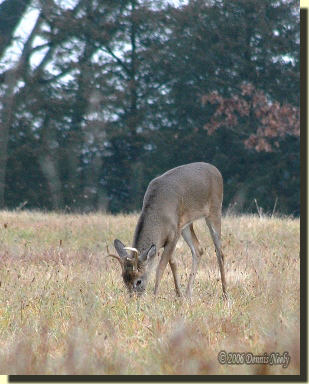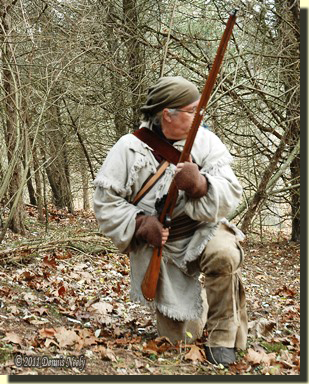Daylight waned. Two gray squirrels frolicked, uphill, forty paces ahead. Half-hidden by boughs, a plump fox squirrel leaped from cedar top to cedar top. The hired hunter did not glance up, but detected the movement. A blue jay perched on a twisted lower branch of a shagbark hickory, cocked its tufted head, but did not utter a warning.
The air on that late-October eve smelled of rain with a hint of drying field corn from the distant homestead. The toe of the woodsman’s buffalo-hide moccasin weaseled under brittle oak leaves. His body, hunched, steady and under control, paused. After a minute or so, this forest tenant executed another increment in his solitary course.
Leaves crackled, then rustled with a broken cadence. Up the hill, beneath a maple sporting a smattering of crimson leaves, a shadow stepped. Another foreleg…another…a hind quarter… A deer’s head popped up, checked its back trail, flicked its ears and walked north to south, parallel with the woodsman’s journey. A second doe appeared, displaying the same casual caution of the first. A third trailed.
The deer angled downhill, yet remained upwind of the backcountry hunter. Heads bobbed up and down with regularity, each lingering up four counts. First one, then the second slipped behind the dark mass created by several fallen cedar trees, fifty paces distant. When the third deer’s head dropped to the trail, the woodsman knelt, counting all the while.
The trio had been gone about ten minutes when another deer shape ventured down the trail. This whitetail acted different from the first group. It scented the trail and spent little time with its head up, enough to be safe, but no more. A small white tine flashed as the young buck wandered back and forth. He pawed and sniffed.

From the antics, the hired post hunter expected the buck to follow the other deer on the same trail, but it did not. Instead, the fork horn buck changed course, choosing the south island crossing. Quick steps grew closer and closer. The buck was scrawny and lean, more bone than meat. Not a choice for Samuel the Trader’s hand-hewn dining table.
Unaware of the hunter’s presence, the deer passed twenty paces upwind without so much as a side-wise glance. The crunching march continued to the edge of the great swamp. The buck’s demeanor changed as it stood and surveyed the sedge grass, elders and red willows that surrounded the little stream that babbled between the cut bank and the oak-covered island.
The small antlered deer stepped into the swamp, made dainty splashes, then vanished into the mass of twigs and branches. Thick gray clouds meant total darkness was minutes away. With great trepidation the woodsman got to his feet and walked off into the night…
Scouts and Spies
The complexion of that wild turkey chase, in the Year of our Lord, 1796, changed after the fork horn passed. The day was not finished, and neither was the time-traveling adventure. However, the degree of caution exercised in the afternoon’s stalk diminished with impending darkness. Returning to the campsite before the fall of the black abyss that accompanies a moonless night was a challenge, but a period-correct challenge.
In reality, legal shooting hours passed a few minutes before the first doe appeared. The Northwest gun’s priming was scattered about the forest floor, the frizzen flipped up and the cock set down. But that minor intrusion of 21st-century game laws did not impact the wilderness jaunt or impose a need to cross back over time’s threshold.
Of late I have been re-reading Gerry Barker’s book, Some Thoughts on Scouts and Spies. It’s been a while. What better way to spend an hour sitting in a parking lot? In truth, I would’ve read the same book if I was sitting in the waiting room.
The Preface sets the tone for the book: “This book is the product of watching other people, of spending time scouting, and some reading. It is not a research work, nor is this intended to tell anyone the right way to do anything; just what I have found by making a lot of mistakes in the woods. I have been lost, caught by the enemy when I did not want to be, skunked by deer, and let my party get far too close to danger…” (Barker, 5).
Barker’s admissions fit traditional black powder hunting, a hands-on endeavor where trial and error learning is the best educator. Failure is success, but in a hidden and mysterious sort of way. I cannot begin to count the number of times I have outfitted myself as described in an old journal, only to fail over and over before realizing the guiding passage was edited by a non-woodsman to fit a book publisher’s romantic image of 18th-century life.
This is especially true when it comes to the captive narratives, which appeared “after the fact” in the first quarter of the 19th-century. This captive narrative genre became the first form of American literature. However, it was filled with underlying agendas, rigid stereotypes and political persuasions, which sometimes hinder a dedicated living historian beyond belief.
The section on “Movement” rang true for me and my alter egos. So many times at outdoor shows, seminars or speaking engagements the question arises, “How can you hunt without camouflage?” The answer is always the same, “I am using camouflage, 18th-century clothing in a 1790s setting.”
Oh, the looks some folks come up with. In response, I have a few pages in the traditional hunting photo albums that I leaf to, showing in-the-field images of traditional woodsmen and women. In some, it’s nearly impossible to find the hunter!
Likewise, when the discussion turns to the “need for camouflage clothing,” the historical me points out that “movement is the key to detection.” Standing still, the hired hunter caught the leg stepping of the first doe, the head bobs of the second and the sniffing about of the young buck.
Suppose the hunter had been walking, even at a slow pace, north to south on a trail halfway down the hillside? The approach of the doe, her cautious “step and look” taught to her by her dam, would have seen the woodman’s progress and she would have chosen a different course. And if not that doe, her summer fawn.
“The movement of a scout must be silent, slow and cautious,” Barker writes. “Major Rogers’ admonition to move like you are sneaking up on a deer is wise. Good deer hunters move like deer…Often stopping for long periods of time, deer stand motionless, carefully searching the land ahead for danger. Scouts spend a lot of time looking and listening…He squats down from time to time…” (Ibid, 20 – 21).

Like so many aspects of traditional black powder hunting, movement in the forest in an 18th-century manner is an acquired skill. The learning comes from “making a lot of mistakes in the woods,” as Barker says.
On that October evening in 1796, Samuel’s hired man made all the right moves, or rather paused and stayed put, which allowed the deer to pass. Unfortunately, that does not always happen. Deer are skilled forest tenants. Survival is their game. In a 1796 context, the post hunter might have taken the fork horn despite the animal’s meager appearance—some meat is better than none. His woodland abilities put him in a position to do so. The deer’s death would have been period-correct; perhaps another tale nestled in a hunter hero’s journal?
I picked up …Scouts and Spies with a purpose in mind. There is no “off season” for a traditional black powder hunter. Yes, prime game is protected, and it was, more by tradition than law, in the 1790s, but that doesn’t mean a post hunter cannot venture back to yesteryear. A “scout” is always in order, no matter how long or how short. The historical context may vary from the simple pursuit, but the relevance is still there.
In the summer months, my emphasis on any trip afield changes. Rebuilding shelters is a key goal for the next few months. I am making progress on differentiating the material goods that go with each persona, and that is a year ‘round task. Will I achieve those goals? Maybe, maybe not… Shelter or not, a new knife, ‘hawk or moccasins or not, the first priority is to get afield.
And then there are the special scouting projects, which are different from the actual hunts. One has been percolating for several years, a woodland scenario predicated on a common 18th-century occurrence that doesn’t get much attention in the re-enacting world. Past attempts have failed to materialize due to unforeseen issues, but that is life.
With renewed vigor, the research is almost complete. The preliminary plans are drawn to scale, and I’m mulling over the final design/construction details with hopes of starting this special project in mid-July. Will it happen this year, maybe, maybe not… Yet, a moccasin step forward, no matter how long or short the stride, is still a moccasin step forward.
At any rate, the re-read of Gerry Barker’s Some Thoughts on Scouts and Spies pumped renewed enthusiasm for the summer months. As I read along, I have no doubt there will be other topics of interest that arise. I’ll share my thoughts when they do. It only takes a sentence or two to spark this living historian’s exuberance.
Give traditional black powder hunting a try, be safe and may God bless you.


